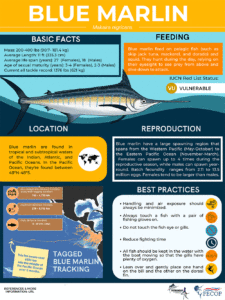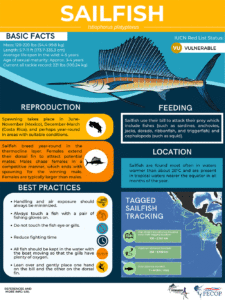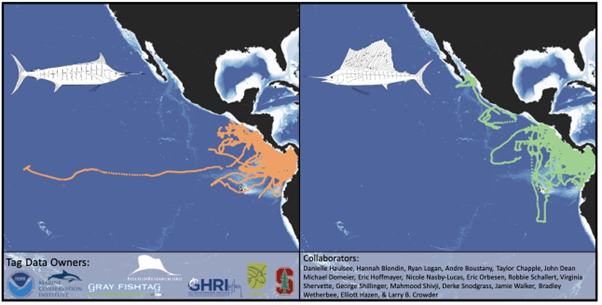Facts, Sources and Infographics
Link to full PDF in English and Español
 Blue Marlin (Makaira nigricans)
Blue Marlin (Makaira nigricans)
- Current all tackle record:
- 1376 lbs (624.14 kg) (IFGA)
- What is their average size (length, weight)?
- Average Length: 11 feet (FECOP, National Geographic)
- Weight: 200-400 lbs (90.7-181.4 kg) (FECOP, National Geographic)
- Males do not usually exceed 160kg and 260 cm while females can reach upwards to 700 kg and 445 cm (Nakamura 1972, Hill et al. 1989, Wilson et al. 1991)
- How long do sailfish live?
- Average life span: 27 years (Females); 18 years (Males) (FECOP, National Geographic (Hill et al. 1989)
- Both females and males can live to over 20 years (Wilson et al. 1991)
- When do males and females mature?
- Males mature around 2-3 years old (NOAA, FECOP)
- Females mature between 3 to 4 years old (NOAA)
- Females reach sexual maturation when they are at 265 lbs (FECOP)
- Females are able to spawn 4 times per single mating season, releasing up to 7 million eggs. Only small percent of released eggs (less than 1%) will survive until adulthood (FECOP)
- Size at maturity in EPO for males: often smaller than 220cm EFL (eye to fork length) (Kume and Joseph 1969)
- 230cm EFL and larger are female (Kume and Joseph 1969)
- How can we tell them apart?
- Females are typically larger than males (National Geographic, Nakamura, 1985; Wilson, et al., 1991)
- Reproduction
- The mating season of blue marlins takes place late in the summer or early in the autumn (FECOP)
- Females can spawn up to 4 times during the reproductive season, while males can spawn year-round (ADW).
- Large spawning region that spans from northern waters (10ºN-30ºN) of the WPO from May to October, and travels to the south/southeastern waters of the EPO (south of 10ºS) from November to March (Howard and Ueyanagi 1965).
- In the EPO, Blue marlin larvae are scarce east of 140ºW, and most abundant west of 150ºW (Nishikawa 1985)
- Batch fecundity for Blue marlin can range from 2.11 to 13.5 million eggs (Sun et al. 2009)
- What do they eat? What are their predatory behaviors?
- Pelagic Fish (such as skip jack tuna, mackerel, and dorado) and squid (National Geographic)
- They hunt during the day, relying on their eyesight to see prey from above and dive down to attack (FECOP, National Geographic)
- They are among the fastest fish in the ocean, and use their spears to slash through dense schools, returning to eat their stunned and wounded victims. (National Geographic, FECOP)
- Fishing methods include trolling large whole baits such as bonito, dolphin, mullet, mackerel, bonefish, ballyhoo, flying fish and squid as well as various types of artificial lures and sometimes strip baits. (IGFA)
- Where are they found (temperature, latitude, etc.)?
- Tropical and subtropical waters of the Indian, Pacific, and Atlantic Oceans. (NOAA)
- In the Pacific Ocean from 48°N to 48°S (FECOP)
- Are they susceptible to becoming endangered? How can we prevent that?
- IUCN Red List Status: VULNERABLE (IUCN)
- Decreasing population trend (Globally) (IUCN)
- Black or Blue? – It is hard for most captains and anglers to tell the difference at times unless they are close to the fish. At closer range, one can be quickly and positively identified since it is the only marlin that have rigid pectoral fins that cannot be folded flat up against the body without breaking the joints. It is also set apart by the airfoil shape of the pectoral fins and by its very short ventral fins, which almost never exceed 12 in (30 cm) in length, regardless of the size of the fish. The first dorsal fin is proportionately the lowest of any billfish, usually less than 50 percent of the body depth. The body is laterally compressed, rather than rounded; much more so than in similar-sized blue marlin. (FECOP)
Sources:
FECOP: https://fishcostarica.org/fishing-species-pacific-blue-marlin/
IGFA: https://igfa.org/game-fish-database/?search_type=SpeciesID&search_term_1=63
National Geographic: https://www.nationalgeographic.com/animals/fish/facts/blue-marlin
Nakamura, I.(1983). Systematics of the billfishes (Xiphiidae and Istiophoridae). Seto Marine Biological Laboratory, Kyoto, 396.
Nakamura, I. (1985). An annotated and illustrated catalogue of marlins, sailfishes, spearfishes and swordfishes known to date. FAO species catalogue. Billfishes of the World. (Vol. 5). Rome: United Nations Development Programme Food and Agriculture Organization of the United Nations.
Hill, K., Cailliet, G., Radtke, R. (1989). A Comparative Analysis of Growth Zones in Four Calcified Structures of Pacific Blue Marlin Makaim nigricans. Fishery Bulletin. 87.
Wilson, C.A., Dean, J.M., Prince, E.D., Lee, D.W. (1991)An examination of sexual dimorphism in Atlantic and Pacific blue marlin using body weight, sagittae weight, and age estimates. Journal of Experimental Marine Biology and Ecology, 151(2), 209-225.
Kume, S., J. Joseph. (1969). Size composition of billfish caught by the Japanese longline fishery in the Pacific Ocean east of 130W. Bulletin of Far Sea Fishery Research Laboratory, 2, 115-161.
Howard, J. K., Ueyanagi, S. (1965) Distribution and Relative Abundance of Billfishes (Istiophoridae) of the Pacific Ocean. Studies in tropical oceanography, 5. Inst of Marine Science, University of Miami Press
Nishikawa, Y., Honma, M., Ueyanagi, S., and Kikawa, S. (1985). Average distribution of larvae of oceanic species of Scombroid fishes. 1956–1981. S Series 12, Contribution 236, Far Seas Fisheries Research Laboratory
Sun, C.-L., Chang, Y.-J., Tszeng, C.-H., Yeh, S.-Z., Su, N.-J. (2009). Reproductive biology of blue marlin (Makaira nigricans) in the western Pacific Ocean. Fishery Bulletin, 107(4), 420-432
 Sailfish, Pacific (Istiophorus platypterus)
Sailfish, Pacific (Istiophorus platypterus)
- Current all tackle record:
○ 221 lbs 0oz ( 100.24 kg) (IFGA)
- What is their average size (length, weight)?
- Mass: 120-220 lbs (54.4-99.8 kg) (FECOP; National Geographic)
- Length: 5.7-11 feet (173.7-335.3 cm) (FECOP; National Geographic)
- How long do Sailfish live?
- Sailfish can reach an age of about 11 years in the EPO. (Hinton and Maunder, 2011)
- The average age of catch and release specimens is 4-5 years (Prince et al. 1986)
- When do sailfish mature?
- Pacific Sailfish are estimated to reach adulthood at a length of 162cm. Based on this size, it is inferred that individuals generally reach sexual maturity at the age of 3-4 years and continue to grow throughout their lifespan. (ADW)
- How can I tell males and females apart?
- Males and females look alike, but some studies have shown that larger sailfish tend to be female (Ehrhardt et al. 2006)
- What do they eat? What are their predatory behaviors?
- Sailfish in the Pacific region feed on fishes and cephalopods including squid. Fishes consumed include sardines, anchovies, jacks, dolphin, ribbonfish, and triggerfish (Florida Museum; Ehrhardt et al. 2006)
- Sailfish use their bill to stun individual fish or attack groups of fish (FECOP)
- Where are they found (temperature, latitude, etc.)?
- Sailfish are found most often in waters warmer than about 28°C and are present in tropical waters nearer the equator in all months of the year (Hinton and Maunder, 2011)
- Are they susceptible to becoming endangered? How can we prevent that?
- IUCN Red List Status: VULNERABLE
- Decreasing population trend (Globally) (IUCN)
- Reproduction
- Sailfish breed year-round in the thermocline layer. Females extend their dorsal fin to attract potential mates. Males have been observed chasing females in a competitive manner, which ends with spawning for the winning male. (FECOP)
- Spawning takes place off the coast of Mexico during June-November, and off Costa Rica during December-March, and perhaps year-round in areas with suitable conditions. (Hinton and Maunder, 2011)
Sailfish sources:
FECOP: https://es.fishcostarica.org/pez-vela/
FAO Species Catalogue: https://www.fao.org/3/ac480e/ac480e00.htm
IGFA Gamefish Database: https://igfa.org/game-fish-database/?search_type=SpeciesID&search_term_1=65
Animal Diversity Web: https://animaldiversity.org/accounts/Istiophorus_platypterus/
National Geographic : https://www.nationalgeographic.com/animals/fish/facts/sailfish?loggedin=true
Hinton, M. G., & Maunder, M. N. (2013). Status of sailfish in the Eastern Pacific Ocean in 2011 and outlook for the future. In Inter-American Tropical Tuna Commission Scientific Advisory Committee 4th meeting La Jolla, CA. SAC-04-07c.
Prince, E., D. Lee, C. Wilson, J. Dean. (1986). Longevity and Age Validation of a Tag-recaptured Atlantic Sailfish Istiophorus platypterus, Using Dorsal Spines and Otoliths. Fishery Bulletin, 84(3), 493-502.
Ehrard, N.M., Deleveaux, V. K. W. (2006). Interpretation of tagging data to study growth of the Atlantic sailfish (Istiophorus platypterus). Bulletin of Marine Science, 79(3), 19-725.
Best practices for sportfishing:
- Minimize handling and air exposure
- Use fishing gloves when handling fish
- Do not touch the fish’s eyes or gills
- Reduce fighting time
- Keep fish in water with the boat moving so gills have enough oxygen
- Lean over and gently place one hand on the fish’s bill and the other on the dorsal fin
- Use circle hooks
- Catch, photograph, release
Sources:
Brownscombe, J.W., Danylchuk, A.J., Chapman, J.M., Gutowsky, L.F.G., Cooke, S.J. (2017)
Best practices for catch-and-release recreational fisheries – angling tools and tactics. Fisheries Research. 186(3), 693-705





















